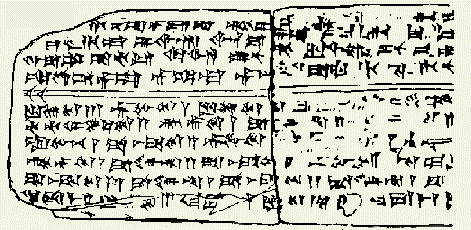It’s incredible to think how humans’ artistic creativity has evolved over thousands of centuries. Music is one of the unique and defining characteristics known to humanity. However, the lack of archaeological evidence proves that how little we know about the actual origins of music, although it is believed to have existed for at least 55,000 years.
One of the only few earliest known musical works was unearthed a few decades ago. It is called the Hurrian Songs, a collection of music inscribed in cuneiform clay tablets that dates to circa 1400 B.C.E. The thirty clay tablets were excavated in the 1950s from the ruins of a royal palace in the ancient city of Ugarit, which is the present-day Ras Shamra in modern Syria.
One of the tablets contains an almost-complete musical composition, called the “Hurrian Hymn.” It is also known as the “Hurrian Hymn to Nikkal,“ “Hurrian cult hymn,” “A Zaluzi to the Gods,” or simply, “h.6.”
Well, here it is:
The system of music notation that we are familiar with today did not exist until after 1000 A.D. In the Hurrian Hymn, its system of music notation is altogether different. The notation is basically a set of instructions for intervals and tuning based around the heptatonic diatonic scale. It is played on a nine-string lyre.
Owing to its near-intact state compared to the other 29 musical texts, the Hurrian Hymn is the only hymn that could be reconstructed and interpreted, although the name of its composer is now lost.
What are the lyrics of the Hurrian Hymn and what do they mean?
Academics and archaeomusicologists have found deciphering the ambiguous Hurrian Hymn text challenging because the Hurrian language is not yet completely understood. Another factor compounding translation problems is the small gaps caused by the missing flakes of the clay tablet.
Despite difficulties, scholars have found out that the hymn was written in Ugaritic, an extinct Northwest Semitic language. For now, the entire lyrical content of the Hurrian Hymn remains partly concealed. However, a translation of the lyrics by Hans-Jochen Thiel in 1977 is regarded as the most approximate translation so far. Dr. Richard Dumbrill interpreted the song’s melody, and his own rendering is only one of the several other academic interpretations of the song’s melody.
The Hurrian Hymn is clearly a religious song. It is dedicated to the Hurrian goddess Nikkal, the goddess of the orchards and wife of the moon god, Yarikh. It is sung as an invocation to Nikkal to bestow her fertility to women who could not bear children.
The following is a partial translation of the Hurrian Hymn, based on the extant portion of the original Ugaritic text:
“(Once I have) endeared (the deity), she will love me in her heart,
the offer I bring may wholly cover my sin,
bringing sesame oil may work on my behalf in awe may I…
The sterile may they make fertile.
Grain may they bring forth.
She, the wife, will bear (children) to the father.
May she who has not yet borne children bear them.”
Interesting Facts About the Hurrian Hymn
If you want to learn more about the Hurrian hymn, here are some other interesting facts about it:
- The Hurrian hymn dates back to approximately 1,400 BCE and is considered to be one of the earliest examples of ancient music. It even predates the Greek and Roman musical traditions by many centuries!
- The Hurrian hymn was discovered in the 1950s on a clay tablet. Inscribed with Cuneiform text, the hymn is the oldest surviving song and is over 3,400 years old.
- The clay tablet text, discovered along 30 other tablet fragments, specifies nine lyre strings. The intervals between those strings are kind of like an ancient guitar tab. But the Hurrian hymn is the only one that could be reconstructed.
- It was discovered in the ruins of the ancient city of Ugarit, located in modern-day Syria.
- The exact content of the Hurrian hymn is unknown since the language isn’t well-understood, and its musical notation is hard to interpret. But the hymn is believed to be for praising the goddess Nikkal and a prayer for her blessings. Nikkal is the goddess of the orchards and the wife of Yarikh, the moon god.
- The hymn consists of 27 lines of musical notation, which have been interpreted by musicologists and performed by musicians.
- The Hurrian hymn’s musical notation was challenging to interpret because the music notation system that we use now wasn’t invented until 1,000 AD.
- The Hurrian hymn was considered to be a beautiful and haunting piece of music.
- The Hurrian hymn serves as a piece of evidence that music was practiced in the ancient world near the East. It’s an essential artifact in the study of ancient music. It’s an important artifact that gives us a glimpse into the religion and music of ancient civilizations.
